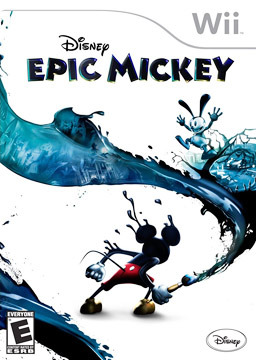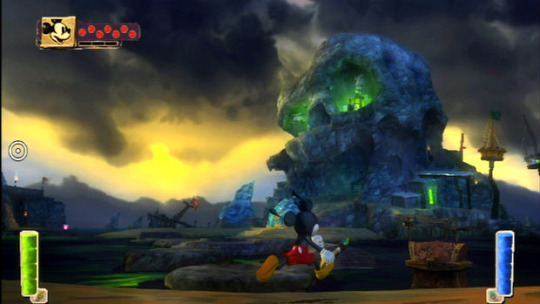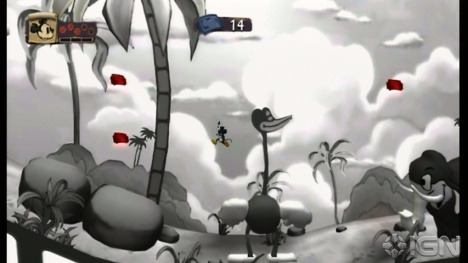#(for the way she refers to her ghost half as this monstrous thing directly to him) but more than anytjing for the fact that it all happened
Text
Epic Mickey Review (Wii/2010)

There are few American game-designers as influential as Warren Spector. As a producer and/or director, he was involved with the creation of the choice based first-person RPG with “Ultima Underworld”, the cyber-punk choice based RPG-Shooter with “Deus Ex” the first person stealth genre with “Thief”, the cinematic narrative game with “Wing Commander” and the first person isolation horror game with System Shock. All of these games are serious, narratively dark, and deeply ambitious experiments in choice and consequence which heavily influenced recent gaming trends. So, it may seem a little odd that after starting a new studio in the Mid-2000s, he would put together a large and talented team to make… two 3-D platforming games starring Mickey Mouse. I skipped the Epic Mickey games when they were released, but was recently surprised when Warren Spector declared them to be his personal favorite games from his illustrious career. As a big fan of Warren Spector’s original work, and an increasingly large Disneyphile, I felt like I needed to go back and give the first one a shot.
At the start of Epic Mickey, the titular character finds a magic paintbrush which can be used to create or destroy objects at will. While he experiments with the brush, he accidentally spills toner into a mystical portal. Mickey, thinking he has cleared up the chaos, returns to his daily life only to be pulled into the portal in the middle of the night. He finds himself in a world referred to as the “Wasteland”, which is where forgotten characters go to live out the rest of their lives. Here, Oswald the Lucky Rabbit, the Walt Disney created character from the 1920s who was the precursor to Mickey Mouse, rules over other forgotten characters like Horace Horsecaller in environments based on some of Disneyland’s original attractions. Mickey very quickly learns that the Wasteland have been transformed into drab half melted cityscapes due to the “toner incident” which let loose the monstrous blot into their world. On top of that, sinister blotlings are capturing residents and converting them into creepy animatronics. Finally Oswald himself, already jealous that Mickey replaced him in the real world, lost his girlfriend in the event. Mickey, determined to return to the real world, and perhaps even make things right, sets out with the magic paintbrush to stop the blotlings and their animatronic allies.

Epic Mickey is an odd game. Despite its status as a platformer, the title actually has a fair amount in common with some of Warren Spector’s earlier work. Much of the level design revolves around your use of toner and paint abilities to melt walls and platforms or create new ones. Some of the platforming areas, and all of the bosses, provide you with multiple ways to unlock the exit, some of which use your powers to solve puzzles and rebuild the areas infrastructure, while others cause chaos and mayhem before smashing out the door or melting down your adversary. While these decisions can feel like “good” or “evil” choices, the game never has you press A or B for specific decisions; rather consequences arise organically. I have at times made the “evil” decision simply because I assumed that was the solution the game was asking me to go for, only to see the aftereffect and realize I’ve made the lives of some of the characters a little bit harder. Once I got a hang of the tools the game provided me with, I found finding the positive solution to any given problem both rather rewarding and often far more challenging than I expected.
On the other hand, it’s difficult to get around the fact that, as a platformer, Epic Mickey largely fails. Mickey himself feels surprisingly difficult to control. The jumps are less responsive than in most similar games, which led to a lot of mistimed leaps. The motion controls, which are used to spray paint, frustratingly can’t be utilized while you’re jumping, while the paint button would sometimes fail to trigger. Worse, the game has an absolutely abysmal camera, often switching angles in ways that would lead to me tumbling to my death. Sometimes the wall behind me would block my view, which has gameplay implications, as pressing the “paint” or “thin” button will often make Mickey think you want to spray the wall behind him rather than the enemy you are initially targeting. The combat, meanwhile, feels particularly weak. Nearly all of the enemies in the game can be “rehabilitated” through the use of paint, which involves slowly rotating around them to avoid attacks as you hold the paint button on them for 10 seconds or so. That enemy will then fight the other enemies, and you’ll navigate the chaos as you attempt to rehabilitate everyone. The problem is that there are certain animatronic enemies you need to use your thinner on in order to defeat, and those ones often have a target hidden under their armor you have to hit. If those enemies are attacking your helper minions it can be much more challenging to find their weak point. The fact that the game revolves around choosing to defeat your enemies or redeem them but still requires you to kill some foes feels a tad weird.

But despite these problems, the game’s world continued to draw me in. As a disneyphile, Epic Mickey is a love letter to the company’s earliest history. There is a real pathos to seeing these forgotten Disney characters struggle to cope with the fact that the world has continued on without them. There is something sad about Mickey meeting characters who once starred alongside him who even he has forgotten. The designers have filled the world with references to those classic 1920s through 40s Mickey and Oswald shorts. As someone who has made a point to watch all of them, I often had a big goofy smile on my face as I walked into the various iterations of Pete or ran into obscure, but identifiable characters like Clarabelle Cow. Epic Mickey leans especially hard into that history in short side-scrolling sections which you visit as you travel from area to area. These little bits are direct adaptations of various shorts, such as the classic “The Lonesome Ghosts”, and “Steamboat Willy”, and are filled with characters and obstacles that directly reference classic gags. The black and white ones in particular are ingenious. As if all those references weren’t enough, Warren Spector made the brilliant decision to base each 3-D environment on classic Disneyland attractions. As someone who loves the Disney Parks and has a fascination for their history, I found something cool around every corner. There is something genuinely charming about jumping through environments based on the various segments of the “It’s a Small World” ride before fighting against the giant clock that presides over its façade. Later I wandered into an enchanted Tiki shop outside of a “Pirates of the Caribbean” themed sequence which culminates in an encounter with an animatronic Captain Hook lifted right out of the “Peter Pan’s Flight” attraction. Every one of these levels are filled with references to the park, some which anyone who has been there would recognize (like Space Mountain rising above Tomorrow City), while others, like scaling the ruined remnants of the Mission to Mars attraction, are sly winks to hardcore aficionados. One particularly clever level has you scaling “the Matador” ride from Disneyland, except the exterior of it is formed from discarded Mickey merchandise from the earliest days of the company, some of which are in the Walt Disney museum at Disney World. Jumping from a Mickey Mouse club button onto the arm of a tacky souvenir phone before running along discarded cartridges from long forgotten 1980s Mickey videogames is tremendously clever. While the Wii’s visuals are obviously, unimpressive from a modern context, the art design manages to shine through the muddy textures. There are no straight lines in this game, rather, like the original shorts it’s based on, the world is made of odd and quirky curves. Each world, from the Haunted Mansion themed Lonesome Manor through the bulbous Space environments of Tomorrow City uses color in new and interesting ways. There is clearly a lot of love on display here.

It’s when the game slows does between worlds that the seams start to show the most. Each world you complete unlocks a new “hub” area filled with NPCs who provide you with sidequests. These NPC designs are repeated endlessly, with only a few basic models, which can make it hard to remember who you’ve talked to. In order to unlock the next world, the player has to collect a small number of power sparks, which are given to you for solving various problems (or causing some mayhem for the more mischievous residents). Many of these tasks involve you travelling back and forth between the various areas. This type of backtracking is always annoying, but it’s particularly egregious in Epic Mickey. Let me give you a quick example of why this is a problem. When I first unlocked the Ventureland area, I travelled there by going through a short side-scrolling level based on an early 1930s short set in the jungle. Upon arriving in the town, I’m given a quest to help a lovelorn pirate win the heart of one of the local residents. In order to win her over, the pirate asks me to travel to Ostown in order to collect flowers. To get there, I have to go back to the projector through which I entered, which cues a 30 second load screen, repeat the side scrolling segment from the other direction, which takes about two minutes before cueing another 30 second load screen. I’m now in the Mean Streets Hub, and I have to go through a separate projector to Ostown. To get there, I have to go through a side scrolling section I have, at this point, already done four time based on the classic “Through the Looking Glass” short. This involves two more 30 second load screens and another two minute trek. After talking to Clarabelle Cow in Ostown, she informs me that she can give me the flowers but first she wants me to drop off a cake with Horace Horsecollar back in “Mean Streets”, which takes me back into the “Through The Looking Glass” level again, which means another two load screens and another two minute trek, followed by a quick run through “Mean Streets”, and two 30 second load screens as I enter Horace’s house, drop off the item, and leave. I then have to return to Clarabelle Cow, which means another two load screens back and a third trek “Through the Looking Glass”. Clarabelle Cow then gives me the bundle of flowers, which means I have to go back to “Mean Streets” again, through the same side scrolling level (now my fourth trip during this one side quest), and then back through the jungle area again (for now my third time), to drop off the flowers. That one throw-away fetch quest took about 20 minutes overall, about 18 minutes of which were spent either repeating a run through the same sidescrolling environment or in a load screen. As you can imagine, I did as few sidequests as I could to complete the game.

In another baffling choice, most environments hide secret “pins”, a reference to the collectables that you can find at the various Disney Parks. But only a few of them are named or have specific art. These pins are provided for solving challenging side content, so it’s weird to do something elaborate in an area, only to reach the end and receive a nondescript “silver pin”. It makes finding which ones you’re missing far too challenging. I felt disappointed every time I completed something I thought would give me an upgrade only to find that I had earned one of these instead.
Yet, every time I found myself getting frustrated with poor design decisions like those, I would enter a new 2-D area (most of which you only go through once) and marvel at the original art or some of the new ideas on display. I would feel excited to walk around the corner in a zone only to see the Astro-Orbiters from Disney Land serving as the means to reach the People Mover which jets around the area. Every time I would stumble because of a poor camera angle, I would have at least one moment where I would do something like melt a cord from the roof with my toner which would help create a path I could use to circumvent an area entirely. There is nothing quite as rewarding as using my ingenuity to find a solution around what would otherwise have been a frustrating platformer challenge. Just as I would start to get bored with painting a group of enemies in order to turn them to my side, a new boss encounter which could be solved in a myriad of ways would pop up, and I’d spend a good 10 minutes trying to figure out how I could rehabilitate this villain instead of melting him down, Every time I’d feel angry at another dumb fetch quest stopping the flow of the game flat, a charming cutscene would play which would provide a character like Oswald with a surprising amount of pathos and depth.

How much you like Epic Mickey is likely to be determined by how appealing you find its world to be on a conceptual level. If the idea of adventuring through lovingly crafted environments based on the classic 1930s-60s Disney content appeals to you, or you have any appreciation for Disney Parks history, this game is going to have a lot for you to love despite some issues which, while glaring, will seem like moments of frustration between bouts of enjoyment. If you just want a fun platformer with some cool mechanics, you’ll find a subpar adventure whose fresh ideas and clever level design are often undermined by imprecise mechanics, frustrating backtracking and a shoddy camera. Since I’m not pretending to be professional critic, I can just give it a score for each scenario. Speaking personally, I, like Warren Spector, really love this game, although I also believe his other work is objectively better. I will definitely get around to playing the sequel at some point though.
If you are a Disneyphile (or want to be) - 8/10
If you aren’t – 4/10
0 notes